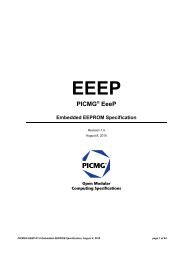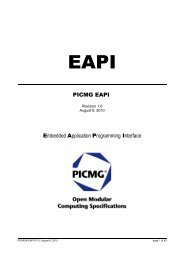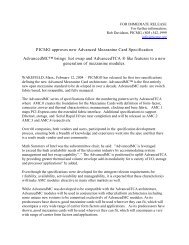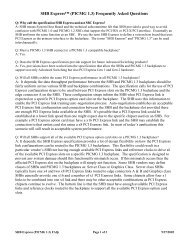PICMG 2.14, CompactPCI Multicomputing
PICMG 2.14, CompactPCI Multicomputing
PICMG 2.14, CompactPCI Multicomputing
Create successful ePaper yourself
Turn your PDF publications into a flip-book with our unique Google optimized e-Paper software.
<strong>CompactPCI</strong> ® <strong>PICMG</strong> ® <strong>2.14</strong> R1.0<br />
MultiComputing<br />
Short Form Specification<br />
September 6, 2001<br />
FOR INFORMATION ONLY; DO NOT ATTEMPT TO DESIGN<br />
FROM THIS DOCUMENT<br />
NOTE: This short form specification is a subset of the <strong>CompactPCI</strong> MultiComputing specification,<br />
<strong>PICMG</strong> <strong>2.14</strong> R 1.0. For complete guidelines on the design of <strong>CompactPCI</strong> MultiComputing<br />
implementations, the full specification is required.<br />
For a full copy of the <strong>PICMG</strong> <strong>2.14</strong> specification, go to www.picmg.org, or contact the PCI Industrial<br />
Computer Manufacturers Group at 401 Edgewater Place, Suite 500, Wakefield, Mass., 01880. Phone<br />
781-246-9318, fax 781-224-1239, email info@picmg.org.<br />
©Copyright 1995, 1996, 1997, 2001 PCI Industrial Computer Manufacturers Group.<br />
<strong>PICMG</strong> disclaims all warranties and liability for the use of this document and the information contained herein, and<br />
assumes no responsibility for any errors or omissions that may appear in this document, nor is <strong>PICMG</strong> responsible<br />
for any incidental or consequential damages resulting from the use of any data contained in this document, nor does<br />
<strong>PICMG</strong> assume any responsibility to update or correct any information in this publication.<br />
<strong>PICMG</strong>®, <strong>CompactPCI</strong>®, and the <strong>PICMG</strong>® and <strong>CompactPCI</strong>® logos are registered trademarks of the PCI<br />
Industrial Computer Manufacturers Group.<br />
All other brand or product names may be trademarks or registered trademarks of their respective holders.
INTRODUCTION<br />
FOR INFORMATION ONLY;<br />
DO NOT ATTEMPT TO DESIGN FROM THIS DOCUMENT<br />
This short form specification is a subset of the full <strong>CompactPCI</strong> MultiComputing specification, Revision<br />
1.0 as approved by <strong>PICMG</strong>. This document is meant as a guide for those considering <strong>CompactPCI</strong><br />
MultiComputing applications, but is not a design document. Anyone intending to design a system<br />
employing <strong>CompactPCI</strong> MultiComputing should obtain the full specification from <strong>PICMG</strong>.<br />
<strong>CompactPCI</strong> is an open specification family supported by <strong>PICMG</strong>, a consortium of companies involved<br />
in open architecture computing for demanding applications. <strong>PICMG</strong> develops, administers and maintains<br />
the specifications in this family.<br />
Objectives<br />
The <strong>CompactPCI</strong> MultiComputing Network (MCNet) allows multiple Peripheral Nodes (PN) CPU<br />
boards and one System Node (SN) CPU board to perform inter-processor communications (IPC)<br />
over a <strong>CompactPCI</strong> backplane (or other shared PCI address space) as if they were discrete computers<br />
on a network. The software interface to perform IPC may be the protocol stack packaged with the<br />
operating system using the MCNet as a data link layer, or there may be a direct application<br />
programming interface (API) to the MCNet data link layer driver, bypassing the OS network<br />
protocol stack. The interface to the data link layer is not fully specified, allowing implementers to<br />
choose an interface suited to their application requirements.<br />
An MCNet comprises one System Node and zero to N Peripheral Nodes. An MCNet operates within<br />
1 to M PCI bus segments that are logically one PCI address space. The design will accommodate<br />
over 4,000 PNs per MCNet. An MCDevice may have a PN on one MCNet and an SN or PN on<br />
another, thereby facilitating packet routing between two or more distinct PCI busses.<br />
All System and Peripheral Node service sharing is a function of the operating system’s ability to<br />
provide shared network services via the protocol stacks (e.g. Windows file and print sharing<br />
capabilities, NFS, etc). The MCNet protocol specification accommodates Hot Swap and other fault<br />
management of MCNodes and MCDevices.<br />
Packet buffering is performed in a non-contentious manner, thereby not requiring read-modify-write<br />
locked cycles.<br />
Purpose<br />
Define packet-based communications between heterogeneous PCI agents (MultiComputing) within<br />
the <strong>CompactPCI</strong> system architecture.<br />
Users of <strong>CompactPCI</strong> have expressed interest in seeing standardization in the methods for processor<br />
boards to communicate with each other when co-existing in a shared PCI address space.<br />
Goals<br />
These are goals whose definition will allow multiple vendors with diverse architectures to<br />
interoperate.<br />
• OSI Data Link Layer network model approach<br />
• Discovery and Initialization of heterogeneous devices following system initialization or Hot<br />
Swap<br />
• Buffer structures<br />
• Messaging<br />
<strong>PICMG</strong> <strong>2.14</strong> R 1.0 <strong>CompactPCI</strong> MultiComputing Short Form Specification, page 2
FOR INFORMATION ONLY;<br />
DO NOT ATTEMPT TO DESIGN FROM THIS DOCUMENT<br />
• Supported features (i.e. multi and broad cast, promiscuous mode, nodal quiescing for hot<br />
swap, reset, driver unload)<br />
• Non-transparent bridging devices and resources to be utilized<br />
• Byte ordering<br />
• Hot Swap re-enumeration of bus and effect on system communications<br />
• High Availability (compatible with the pending <strong>PICMG</strong> 2.13 specification for dual-host<br />
high availability)<br />
PROTOCOL OVERVIEW<br />
The purpose of this protocol is to<br />
• Support up to 4096 MCNodes communicating in a heterogeneous (single global PCI memory address<br />
space) PCI environment<br />
• Occupy Layer 2 (data link) of the OSI reference model<br />
• Allow for dynamic discovery and configuration of network elements<br />
• Emulate broadcast and multicast capabilities to allow higher level network protocols to operate via<br />
this data link layer<br />
• Accommodate Compact PCI Hot Swap capabilities<br />
• Provide for fault detection, containment and notification in a High Availability environment<br />
• Allow extensions in subsequent versions of this specification which take advantage of additional<br />
hardware features<br />
• Ensure interoperability among all vendors complying with this specification<br />
The information in this chapter is intended to be descriptive in nature, and is not an actual part of the<br />
specification. Subsequent chapters in the full <strong>CompactPCI</strong> MultiComputing specification specify the<br />
protocol in detail.<br />
Protocol Model<br />
The general model of the MCNet protocol is that of a dedicated shared memory region for the<br />
exchange of messages. The entire protocol takes place within a single global PCI memory address<br />
space. Each MCNode of a pair of MCNodes desiring to communicate allocates regions of the global<br />
PCI memory space for communication and control structures dedicated to that single connection. A<br />
single System Node manages the discovery and setup of the remaining connection pairings on<br />
demand.<br />
MultiComputing Devices<br />
The term MultiComputing Device (MCDevice) refers to actual PCI hardware that conforms to the<br />
PCI specification for a PCI device/function. The MCDevice is discovered and managed by the PCI<br />
enumeration software. Resources are allocated by the PCI system software via the PCI type 0<br />
configuration header mechanism. For a PCI device/function to be an MCDevice, it must have at<br />
least a 4k byte PCI memory space allocation.<br />
MCDevices are important to the <strong>2.14</strong> protocol because they form the basis for communications<br />
among hardware provided by multiple vendors. Additionally, MCDevices are treated as hot<br />
<strong>PICMG</strong> <strong>2.14</strong> R 1.0 <strong>CompactPCI</strong> MultiComputing Short Form Specification, page 3
FOR INFORMATION ONLY;<br />
DO NOT ATTEMPT TO DESIGN FROM THIS DOCUMENT<br />
swappable entities and the MCNet system maintains associations between MCDevices and<br />
MultiComputing Nodes for purposes of dynamic configuration management and fault containment.<br />
MultiComputing Nodes<br />
MultiComputing Nodes (MCNode) are the entities that actually communicate using the <strong>2.14</strong><br />
protocol. An MCNode is the software abstraction that performs the protocol with a second<br />
MCNode. Each MCNode resides on an MCDevice. More than one MCNode may reside on a single<br />
MCDevice. Each MCNode is assumed to have a MultiComputing Node Interface (MCNI), which<br />
provides the abstract connection to the rest of the software running on an MCDevice. MCNet<br />
services are requested and received via the MCNI.<br />
There are two types of MCNodes. Each MCNet must have one and only one active System Node<br />
(SN). All other MCNodes participating in the MCNet are Peripheral Nodes (PN). Both Peripheral<br />
Nodes and System Nodes have an MCNI via which services are provided to associated software.<br />
Additionally, the System Node has a System Node Interface (SNI), which provides the abstract<br />
software definition of additional services required to manage the MCNet.<br />
Monikers and Moniker Assignments<br />
In the <strong>2.14</strong> protocol, every MCNode is known by a 64-bit value called a Moniker. The Monikers are<br />
similar to 64-bit Ethernet addresses. The complete MultiComputing specification describes the<br />
Moniker format in detail. Monikers are characterized as locally administered or globally<br />
administered, and, orthogonally, as individual or broadcast (multicast). An MCNode has an MCNetunique<br />
individual Moniker.<br />
Short Atomic Messages<br />
Short Atomic Messages (SAMs) are used to deal with the PCI bus mutual exclusion problem. While<br />
the PCI specification provides for bus locking mechanisms, bus locking is not widely or consistently<br />
implemented by PCI hardware. Therefore, the SAM mechanism is used in the one area requiring a<br />
shared resource.<br />
The System Map and Moniker Resolution<br />
One of the main functions of the System Node is to maintain a system map of all of the known<br />
MCNodes participating in the MCNet. The system map is built by the SN during initialization of<br />
PNs, which are created by the MCDevice discovery process and other processes. Each call to the<br />
sni_create_node function, and certain control messages within the MCNet, cause the SN to allocate<br />
table space for the new PN's system map entry.<br />
Broadcast and Multicast<br />
In this specification, the term Broadcast is used to represent both the true Broadcast, consisting of all<br />
MCNodes, and Multicast, which is an arbitrary subset of the MCNodes in voluntary association.<br />
True broadcast is used where the group consisting of all MCNodes is meant. Technically, there is no<br />
default true broadcast group, since all MCNet Broadcast Groups require that MCNodes explicitly<br />
join the group in order to receive data packets destined for a particular broadcast moniker.<br />
Since the physical layer characteristics of the PCI bus only allow for point to point communications,<br />
broadcast and multicast functions must be emulated. While broadcast operations are not strictly<br />
required for operation of the MCNet protocol, those functions are provided to ease the use of this<br />
protocol as a data link layer for other network protocols, many of which rely heavily upon broadcast<br />
capabilities.<br />
Emulation of the broadcast capability is provided by introducing an MCNode role called the<br />
Broadcast Group Broker, or simply, Broker. The Broker function is optional for all MCNodes<br />
<strong>PICMG</strong> <strong>2.14</strong> R 1.0 <strong>CompactPCI</strong> MultiComputing Short Form Specification, page 4
Alerts<br />
FOR INFORMATION ONLY;<br />
DO NOT ATTEMPT TO DESIGN FROM THIS DOCUMENT<br />
except the System Node, which provides the default Broker functions for the true Broadcast Group.<br />
The Broker functions are used via the MCNI. All MCNodes provide the broker functions within the<br />
MCNI, but may deny requests for services requiring the Broker functions.<br />
In the context of this specification, Alerts are mechanisms to indicate to an MCNode that a state<br />
change has been effected by another MCNode. The purpose of alerts is to eliminate or reduce the<br />
need for an MCNode to poll its shared data structures to detect state changes.<br />
High Availability Considerations<br />
Considerations for planned removal and unplanned MCNode failure have been designed into this<br />
specification. Redundant MCNode roles have also been considered. However, the level of<br />
redundancy covered by this first revision is limited to cold replacement of MCNode roles.<br />
Additionally, given the nature of the PCI bus, there can be no guarantee that an MCNode failure or<br />
unexpected removal will not result in an unrecoverable bus fault. Care has been taken to provide<br />
system freeze mechanisms that can be quickly propagated in the event of failures, but the<br />
propagation relies on the PCI bus's continued operation.<br />
As a means of detecting "silent" failures, an MCNode heartbeat capability has been incorporated in<br />
the data structures of this protocol. Control messages for creating and specifying the properties of<br />
the heartbeat have been provided, as well as mechanisms for reporting the failure of an expected<br />
heartbeat.<br />
All of the HA mechanisms serve to maximize the probability, but not guarantee, that a failure can be<br />
contained.<br />
Command, Control Messages, and Data Packets<br />
Three types of information exchange are used by this protocol. The first two types apply to all<br />
connections, and allow for the establishment and management of connections, connection resources,<br />
and the expeditious control of an MCNode's activity on the PCI bus. These two mechanisms are<br />
referred to as Commands and Control Messages. Commands take the form of flags or short values<br />
that are written to the connection data structures to effect immediate state changes prior to an<br />
MCNode's continuation of ordinary operations. Control Messages exist in two priority classes,<br />
urgent and normal. There is a queue of up to 15 normal control messages and two urgent control<br />
messages. Urgent messages are processed before normal messages.<br />
The third type of information exchange is called data packet exchange. Data packets are exchanged<br />
as a result of requests to send information to another MCNode. Data packet exchange is the normal<br />
in-band communication of this protocol layer.<br />
Operational Overview of the Protocol<br />
The <strong>2.14</strong> MultiComputing Protocol begins following initialization of the PCI system software. The<br />
SN and SNI are created by the system initialization software in a manner determined by the supplier<br />
or integrator of the system software. Once the SNI is available, the PCI system software, or adjunct<br />
to the system software, calls the SNI with the MCDevices discovered during PCI bus enumeration.<br />
During or following the process of PCI bus enumeration and driver configuration, MCDevices are<br />
discovered, either as a direct result of the PCI enumeration, or subsequently by action of a particular<br />
PCI device driver. For each MCDevice discovered, the SNI is called with the parameters for the<br />
MCNode that will be created on that device. The SNI receives the MCNode parameters and<br />
performs a rendezvous with the Peripheral Node at the location specified by the SNI MCNode<br />
initialization request.<br />
<strong>PICMG</strong> <strong>2.14</strong> R 1.0 <strong>CompactPCI</strong> MultiComputing Short Form Specification, page 5
FOR INFORMATION ONLY;<br />
DO NOT ATTEMPT TO DESIGN FROM THIS DOCUMENT<br />
The Rendezvous of the SN and PN results in a System Map entry being created in the SN, and a<br />
control/command connection between the PN and SN being created. This control/command<br />
connection will remain in existence so long as the SN and the PN remain a part of the MCNet.<br />
During the initial SN/PN connection establishment, certain key parameters are exchanged relating to<br />
the alert mechanism and addressing capabilities of the PN, as well as the operational mode of the<br />
connection. Moreover, the Moniker for the PN is established, either as requested by the SNI service,<br />
or as supplied by the PN by local (to the PN) means.<br />
A connection is established by creation of a Connection Control Block and Bi-directional<br />
Information Block on both MCNodes party to the connection. These structures remain so long as the<br />
connection exists. Data packet exchange is created by control messages requesting the establishment<br />
of a data packet capability, and results in the creation of an additional data structure, the Packet<br />
Information Block (PIB), which contains Transmitter and Receiver information.<br />
Command and Control Message exchanges take place in the CCB/BIB structures. The transmitting<br />
MCNode finds a free resource in the receiving MCNode's data structure, writes the message or<br />
command, updates the receiver's queue indices or flags, and then executes the control message alert<br />
mechanism on the receiver. The receiver then processes the command or message(s) and updates the<br />
queue or flags in the transmitting MCNode's data structures.<br />
If data packet exchange is established between two MCNodes, then data packet exchange takes place<br />
in the PIB data structures. An MCNode wishing to transmit requests allocation of free block(s) from<br />
the receiver. The receiver makes the free block available to the transmitter by writing the free block<br />
information into the transmitter's PIB. Then the transmitter uses the free block and writes the data<br />
packet into the free block. After the data packet has been written, the transmitter updates the packet<br />
descriptor in the receiver's PIB and updates the respective packet descriptor indices. Finally, the<br />
transmitter executes the Data Packet alert mechanism on the receiver.<br />
The receiver of a data packet processes the data packet and passes it up through the MCNI to upper<br />
layer software. Following data processing, the packet descriptor queue indices are updated in the<br />
transmitter's PIB. If the buffer block is now free, the receiver may choose to return the buffer to the<br />
transmitter's free block queue. If the free block list was empty, or the packet descriptor queue was<br />
full, then the receiver will execute the Resource alert mechanism on the transmitter.<br />
Operational Overview of Broadcast and Multicast<br />
In order to receive broadcast data packets, an MCNode must join the broadcast group. It does this by<br />
sending a broadcast Moniker Resolution Request to the SN. The SN responds with the Moniker of<br />
the Broker for that broadcast group. The MCNode then connects with the Broker and makes a Join<br />
Broadcast Group request via the control message queue. The Broker then updates the broadcast<br />
policies so that future data packets to the broadcast moniker will also be sent to the newly joined<br />
MCNode.<br />
When an MCNode wishes to send a data packet to a broadcast group, it contacts the broker for the<br />
group to receive a policy. The policy is the list of MCNodes to which the MCNode must connect<br />
and send the data packet in order to propagate the data to all of the group members. The policy is<br />
requested and received via the control connection to the broker.<br />
While a policy may simply be the list of all MCNodes in the group, optimizations are allowed in this<br />
protocol specification. When an MCNode joins a broadcast group, the MCNode specifies if it can<br />
act as a proxy for the broadcast group. If so the broker may place several MCNodes into what is<br />
called a proxy group. In this case, the broker will provide a policy that includes only some of the<br />
MCNodes in the group. Each broadcast data packet that is sent to a proxy MCNode will be<br />
replicated by the proxy and passed on to the other members of the proxy group.<br />
<strong>PICMG</strong> <strong>2.14</strong> R 1.0 <strong>CompactPCI</strong> MultiComputing Short Form Specification, page 6
















